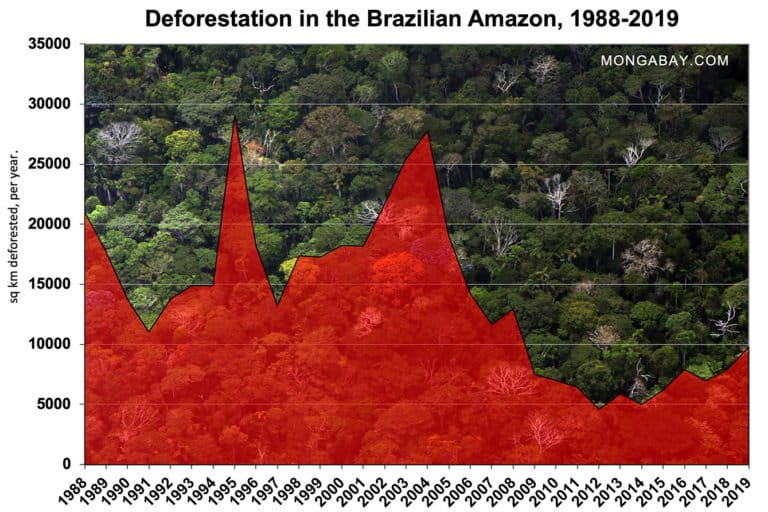- Deforestation during the final five months of 2019 hit the highest level since at least 2006 reveals data released this week by Brazil’s national space research institute INPE.
- According to INPE’s satellite-based deforestation monitoring system DETER, deforestation since July 31 surpassed 4,400 square kilometers, more than twice the clearing recorded for the period a year earlier and 51% above the previous record set in 2007, the first year the the agency started releasing monthly data.
- The data does not include forest lost to fires, which INPE tracks separately.
- The newly released data suggests that forest clearing is on track to surpass last year’s rate.
Deforestation during the final five months of 2019 hit the highest level since at least 2006 reveals data released this week by Brazil’s national space research institute INPE.
According to INPE’s satellite-based deforestation monitoring system DETER, deforestation since July 31 — the end of the “deforestation year” used by the Brazilian government — surpassed 4,400 square kilometers, more than twice the clearing recorded for the period a year earlier and 51% above the previous record set in 2007, the first year the the agency started releasing monthly data.
For the year ended 12/31, DETER registered 8,870 square kilometers of deforestation, which is also the highest amount since monthly record-keeping began.


The data does not include forest lost to fires. Conflagrations in the Amazon made worldwide headlines in August and September when smoke blackened the skies above Sao Paulo, one of the world’s largest cities. Global outcry prompted wider awareness of rising deforestation in the Brazilian Amazon, which accounts for nearly two-thirds the land area of the Amazon, Earth’s largest rainforest.
INPE’s system tracks land burned by forests separately from deforestation. Other research has indicated that most of the area burned during this year’s fire season consisted of recently chopped down forest, agricultural land, semi-tropical transition forest, or scrub, rather than primary tropical rainforest. However fires in the Amazon rainforest typically burn below the canopy and aren’t detectable using conventional systems for tracking fires. While less dramatic than the towering fires burning in drier forests like the Southern Amazon or eastern Australia, sub-canopy fires are still quite damaging in the long-term to the Amazon, leading to increased tree die-off and higher incidence of future fires.

The newly released data suggests that forest clearing is on track to rise again for the year ending August 1, 2019 – July 31, 2020. In November 2019, Brazil released preliminary figures showing that deforestation for 2018-2019 amounted to 9,672 square kilometers, an increase of 30% over the prior year. Final numbers for 2018-2019 should be released in the next few months.

While deforestation has been rising sharply in the Brazilian Amazon in recent years, it remains below levels registered from the late 1970s through the early 2000s, when annual loss regularly topped 15,000 square kilometers. But scientists are concerned that new policies being enacted by Brazilian President Jair Bolsonaro will drive increased deforestation in the long-term, potentially destabilizing the rainforest ecosystem and triggering a shift toward a drier landscape, like the Cerrado and Chaco forests found in the southern Amazon. Such a change would have major implications for rainfall across the region, affecting water availability for power generation, agriculture, and urban areas.